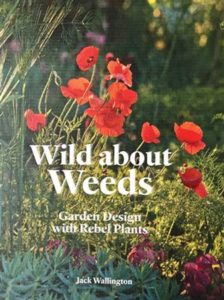Wild About Weeds

March 2020
By Jack Wallington
Laurence King Publishing, 2019
176 pages, hardcover, $24.99
This book may make you stop cringing at the word “weed” (and even “invasive”) and enable you to consider some plants in a different light. Landscape garden designer and garden writer Jack Wallington profiles over 50 weeds and ways they might be used in the garden – with appropriate cautions, when necessary. Wallington has experience with gardens and weeds around the world, so he is well versed in where a particular plant may be OK and where it will behave like a … well, weed.
Wallington discusses the history of weeds, when they can be good in a garden, when they’re not, where to get them, how to grow them and how to design gardens with them. He then profiles individual weeds for various situations. Abundant color photos accompany plant descriptions.
Some, such as evening primrose (Oenothera biennis), I was happy to see. Wallington suggests growing it here and there throughout a garden bed “to draw the eye along, arranging the plant much as it would grow in the wild.” He notes that its flowers can be added to salads and that its seeds are used to make medicinal evening primrose oil.
Likewise, the tall, striking castor oil plant (Ricinus communis), although not native to the United States, is a great focal point in the garden. Wallington does note that the seeds (but not the oil produced from the seeds) are quite poisonous. In fact, ricin from the seeds has been used by assassins. So keep the seeds away from kids. The plant may become invasive in areas warmer than New England.
I was surprised to see giant hogweed (Heracleum mantegazzianum) profiled. Maine newspapers seem to run warnings every summer about the dreaded skin burns that are possible if you encounter the sap of this plant, and Wallington says it is outlawed in the United States. “However,” he says, “if you ever do come across it, take a moment to enjoy its beauty as a plant.” He says that the sap can cause extreme skin sensitivity in sunlight, but, “If sap does come into contact with your skin, it’s not the end of the world, just make sure you rinse the area thoroughly as soon as possible. You would need a lot of sap and a reasonable exposure to full sun to receive severe burns.”
The plants in this book are interesting to know about and, in some cases, depending on where you live, to grow. I won’t be planting gorse or English ivy, but I’ll continue to enjoy the Queen Anne’s lace, ox-eye daisies and red clover that have naturalized among our Christmas trees, while I’ll also strive to grow more natives.
– Jean English

